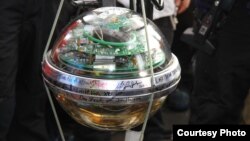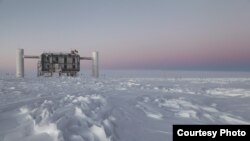Sensors buried deep in the Antarctic ice have detected evidence of high energy particles from outside the solar system. The extraterrestrial discovery could usher in a new age of astronomy and greater understanding of the nature of the universe.
The IceCube Neutrino Observatory at the Amundsen-Scott South Pole station is the world’s largest neutrino collector.
IceCube scientists and engineers assembled digital optical modules (DMOs) - instruments the size of basketballs - and installed them at depths of up to two kilometers under the ice.
Linked to computers by an extensive array of cables, DMOs collect raw data on neutrino activity in near real time by capturing the light emitted when neutrinos strike the ice.
High energy neutrinos rare
These unimaginably tiny, nearly massless particles are the building blocks of the cosmos. They stream from the sun or Earth’s own atmosphere at near light speed. Billions pass through us every second without a trace.
But, these are low energy neutrinos. They are not what interest the 250 scientists from 11 countries working on IceCube.
Principal investigator and University of Wisconsin physics professor Francis Halzen says IceCube is scanning for high energy neutrinos from outside the solar system.
“What we want to see is a handful of events sent to us by the universe. We’ve finally discovered those.”
New research confirms powerful neutrinos
When the neutrinos interact with atoms inside the deep ice detectors, they sometimes give off puffs of light. In 2010, scientists detected two high energy neutrinos and then, last year, 26 more, including the most energetic neutrinos ever observed.
IceCube collaborator and University of Wisconsin physicist Nathan Whitehorn says analysis of that data, published in the journal Science, confirmed their earlier find.
“It was almost impossible without more data and data at lower energies to be sure that these two neutrinos that we found were part of a larger pattern indicating an extraterrestrial population, instead of some statistical fluke.”
Neutrinos ideal candidates for tracing origin of cosmic rays
Neutrinos have almost no mass and no electric charge, so they are unaffected by Earth’s magnetic fields.
They keep up speed and zip in a straight line through the solar system. That behavior is far different from the electrically charged cosmic rays, which rain down on our planet and are easily deflected by magnetic fields. Whitehorn says that makes them ideal candidates to track the origin of cosmic rays.
“We expect that anything that is making high energy cosmic rays, the most energetic phenomenon in the universe, whatever they are, will make neutrinos at the same time and if we are able to identify the origin of these high energy neutrinos, they will provide some very powerful clues about the origin of the highest energy cosmic rays.”
Scientists have been trying to solve this mystery for more than a century, and they hope these extraterrestrial messengers can point the way.
The IceCube Neutrino Observatory at the Amundsen-Scott South Pole station is the world’s largest neutrino collector.
IceCube scientists and engineers assembled digital optical modules (DMOs) - instruments the size of basketballs - and installed them at depths of up to two kilometers under the ice.
Linked to computers by an extensive array of cables, DMOs collect raw data on neutrino activity in near real time by capturing the light emitted when neutrinos strike the ice.
High energy neutrinos rare
These unimaginably tiny, nearly massless particles are the building blocks of the cosmos. They stream from the sun or Earth’s own atmosphere at near light speed. Billions pass through us every second without a trace.
But, these are low energy neutrinos. They are not what interest the 250 scientists from 11 countries working on IceCube.
Principal investigator and University of Wisconsin physics professor Francis Halzen says IceCube is scanning for high energy neutrinos from outside the solar system.
“What we want to see is a handful of events sent to us by the universe. We’ve finally discovered those.”
New research confirms powerful neutrinos
When the neutrinos interact with atoms inside the deep ice detectors, they sometimes give off puffs of light. In 2010, scientists detected two high energy neutrinos and then, last year, 26 more, including the most energetic neutrinos ever observed.
IceCube collaborator and University of Wisconsin physicist Nathan Whitehorn says analysis of that data, published in the journal Science, confirmed their earlier find.
“It was almost impossible without more data and data at lower energies to be sure that these two neutrinos that we found were part of a larger pattern indicating an extraterrestrial population, instead of some statistical fluke.”
Neutrinos ideal candidates for tracing origin of cosmic rays
Neutrinos have almost no mass and no electric charge, so they are unaffected by Earth’s magnetic fields.
They keep up speed and zip in a straight line through the solar system. That behavior is far different from the electrically charged cosmic rays, which rain down on our planet and are easily deflected by magnetic fields. Whitehorn says that makes them ideal candidates to track the origin of cosmic rays.
“We expect that anything that is making high energy cosmic rays, the most energetic phenomenon in the universe, whatever they are, will make neutrinos at the same time and if we are able to identify the origin of these high energy neutrinos, they will provide some very powerful clues about the origin of the highest energy cosmic rays.”
Scientists have been trying to solve this mystery for more than a century, and they hope these extraterrestrial messengers can point the way.










